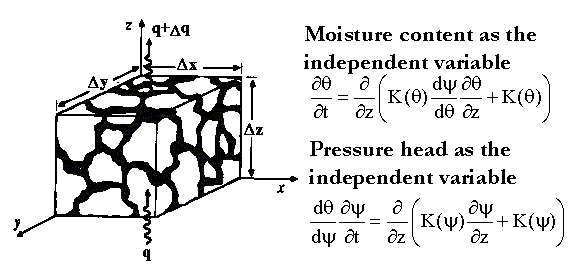At a point infiltration models for calculating runoff
Refer to Chapter 5 of the Rainfall Runoff Processes Workbook
The rate at which water moves into the soil is the infiltration rate. This
rate depends on the soil moisture content, the distribution of soil
moisture content in the soil, and the amount of incoming precipitation
water at the soil surface. The maximum rate that soil can absorb water
is the infiltration capacity. Any
excess surface water input that does not infiltrate, collects on the
ground surface and contributes to runoff as overland flow.

Richards equation
combining conservation of mass and Darcy's equation expressed with
moisture content or pressure head as the independent variable.
Richards equation can
be used to solve for pressure head, or equivalently moisture content
during infiltration or drainage of a soil profile assuming a specific
form for the soil moisture characteristic curves. Except for special cases numerical solutions are required using codes such as Hydrus 1-D.
Even though the
complexity of solving Richard's equation can be overcome with modern
computational methods the practical limits on quantifying soil
properties limit extensive use of Richard's equation solutions. Simplified at a point parameterizations for calculation of infiltration are still used. There are three at-a-point infiltration models presented in this section: Green-Ampt, Horton, and Philips. Using these models one can calculate runoff at a point, given a time series of surface water input and soil conditions. There are three cases to be considered throughout the time series: (1)
excess surface water ponds on the surface throughout the interval; (2)
there is no ponding throughout the interval; and (3) ponding begins at
some time during the interval. The
output of the models is the runoff amount generated from excess surface
water input; the cumulative infiltrated depth of water is the state
variable for the models.
An important concept
that emerges from the Green-Ampt model is that infiltration capacity
during a storm decreases as a function of cumulative infiltrated depth. This
provides for a decrease in infiltration capacity and increase in runoff
ratio with time, consistent with empirical observations. In
the Green-Ampt model, infiltration capacity is modeled as a function of
cumulative infiltration depth, whereas the Horton and Philips
infiltration models calculate infiltration capacity as a function of
time.
The three infiltration
models presented are three of the most popular from a number of at a
point infiltration models used in hydrology. However,
if one does not have enough soils data to attempt to represent the
physics of infiltration using the above models, empirical and index
methods may be used.
The flowchart and
examples in the workbook, Excel spreadsheets and animated solution are
designed to guide you through the procedure for solving these at a point
infiltration models for time varying precipitation input. After working through these you should be able to calculate runoff using one of the at-a-point infiltration models presented.
|

